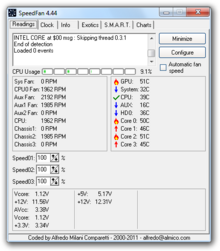SpeedFan is a system monitor for Microsoft Windows that can read temperatures, voltages and fan speeds of computer components.[3] It can change computer fan speeds depending on the temperature of various components.[1][4] The program can display system variables as charts and as an indicator in the system tray.[1][4][5] Fully configurable user events can be defined to execute specific actions based on system status[6]
 SpeedFan 4.44 in Windows 7 | |
| Original author(s) | Alfredo Milani Comparetti[1] |
|---|---|
| Developer(s) | Alfredo Milani Comparetti |
| Initial release | 27 March 2001[2] |
| Stable release | 4.52 (29 June 2016) [±] |
| Preview release | 4.51 beta 2 (7 August 2014) [±] |
| Written in | Delphi, C++, C[citation needed] |
| Operating system | Windows 95 and later[1] |
| Type | System monitor |
| License | Freeware[1] |
| Website | www |
Hard disk support edit
SpeedFan also monitors S.M.A.R.T. readings for EIDE, SATA and SCSI hard disks. Starting with version 4.35, SpeedFan fully supports Areca RAID controllers. Version 4.38 added full support for AMCC/3ware SATA and RAID controllers.[1]
Hard disk in-depth online analysis edit
SpeedFan offers a feature named "in-depth online analysis" that compares the hard disk's S.M.A.R.T. data to a database with statistical models of hard disks allowing early detection of potentially degraded hard disks.[7] Messages inform the user of specific situations and problems, which Almico says is “as if a human expert had looked at the data”.[1]
Reception edit
An extended review of version 4.46 in 2012 on the Silent PC Review website summarized, "The biggest drawback [to Speedfan] is it often takes a lot of work to properly configure", but continued, "Its highly customizable and incredibly powerful nature is unmatched by the competition and as a bonus, it's also free, lightweight and regularly updated with more features and better motherboard support."[8] The Softonic review of version 4.49 graded SpeedFan 8/10, listing it as useful, with "helpful charts to monitor performance and health", but noting that it requests administrator rights at launch, and "Can be intimidating for less tech savvy".[9]
See also edit
- Argus Monitor
- Motherboard Monitor
- System monitor
- Comparison of S.M.A.R.T. tools
- lm_sensors
- hw.sensors
References edit
- ^ a b c d e f g "SpeedFan - Access temperature sensor in your computer". Almico.com. 12 October 2006. Retrieved 15 January 2007.
- ^ "SpeedFan - History". Almico.com. Archived from the original on 5 April 2001. Retrieved 22 November 2013.
- ^ Constantine A. Murenin (17 April 2007). "3.1. SpeedFan". Generalised Interfacing with Microprocessor System Hardware Monitors. Proceedings of 2007 IEEE International Conference on Networking, Sensing and Control, 15–17 April 2007. London, United Kingdom: IEEE. doi:10.1109/ICNSC.2007.372901. ISBN 978-1-4244-1076-7. IEEE ICNSC 2007, pp. 901—906.
- ^ a b Martin, Jim (21 August 2013). "How to check your CPU temperature: use the free SpeedFan utility". PC Advisor. Retrieved 22 November 2013.
- ^ Gralla, Preston (30 August 2011). "PC World Downloads - Speedfan 4.33". PC World. Archived from the original on 10 February 2012. Retrieved 21 November 2013.
- ^ "What's The Normal CPU Temperature Range While Gaming". CPUTemper. 20 June 2020. Retrieved 5 February 2022.
- ^ Savchenko (rarst), Andrey (7 August 2008). Brinkmann, Martin (ed.). "Analyzing drive health with SpeedFan (4.34)". Ghacks blog. Retrieved 22 November 2013.
- ^ Lee, Lawrence (2 July 2012). "SpeedFan: A Guide to Universal Motherboard Fan Control". silentpcreview.com. Retrieved 22 November 2013.
- ^ Leong, Lewis. "SpeedFan (4.49)". Softonic. Retrieved 22 November 2013.